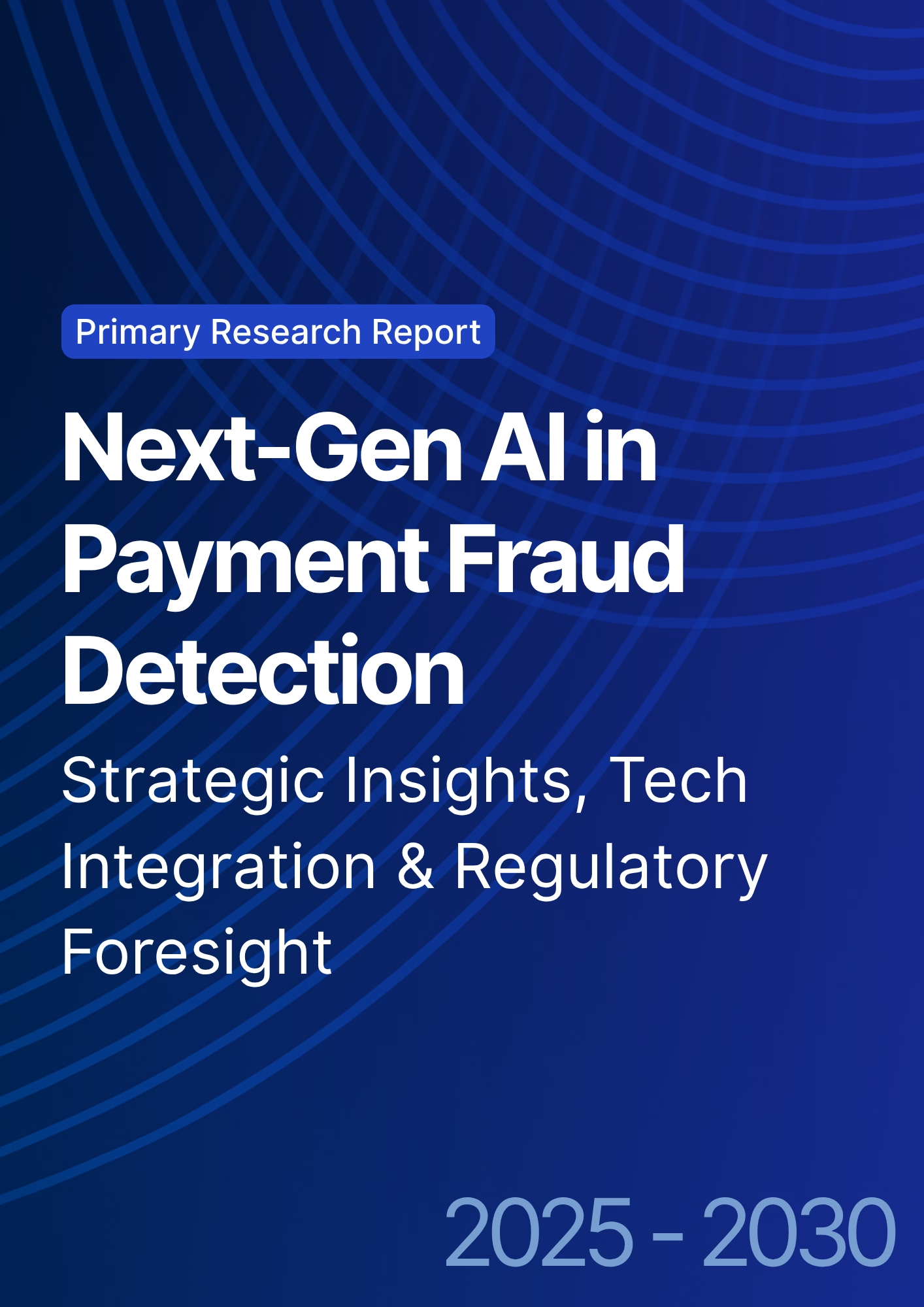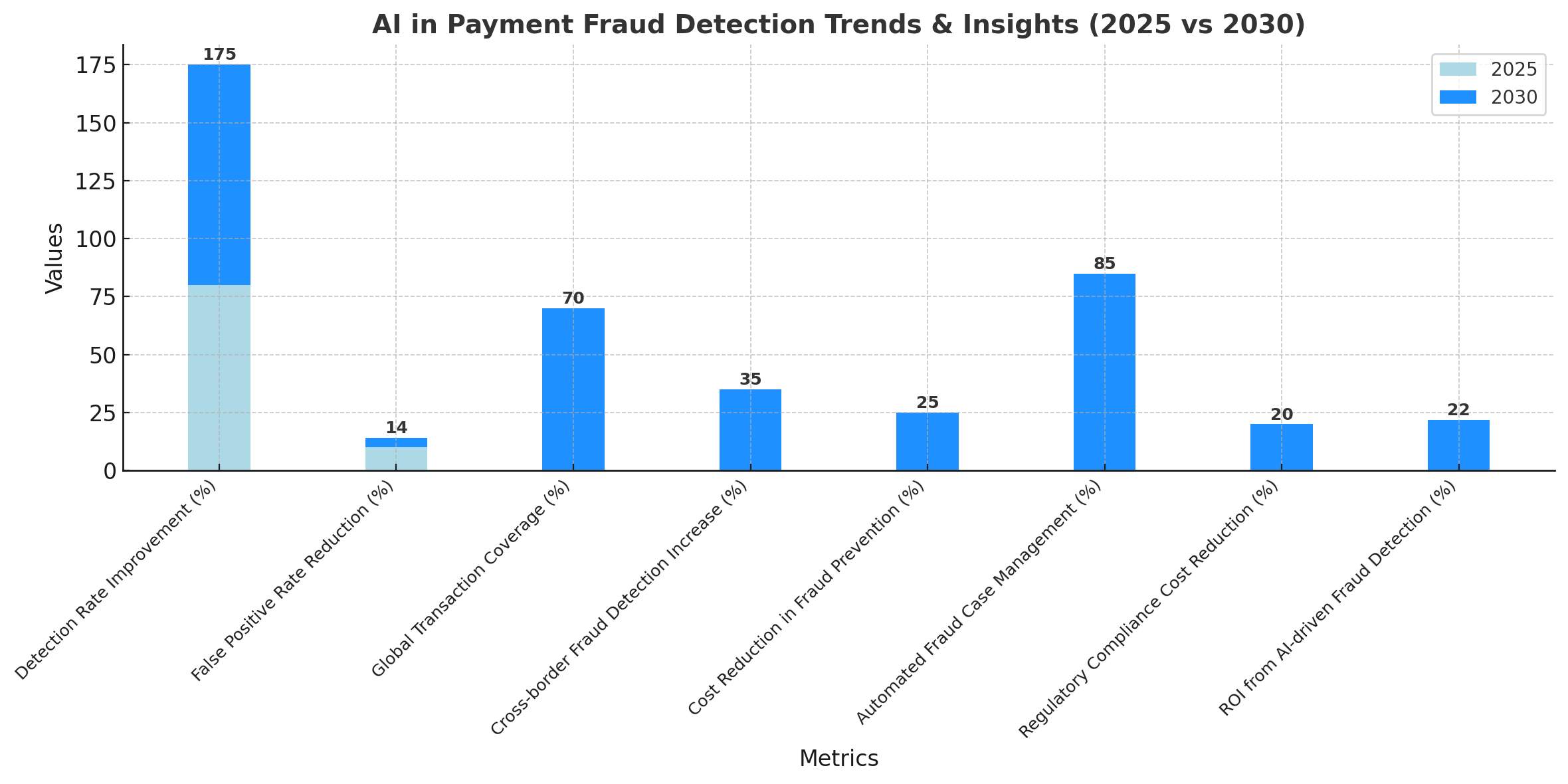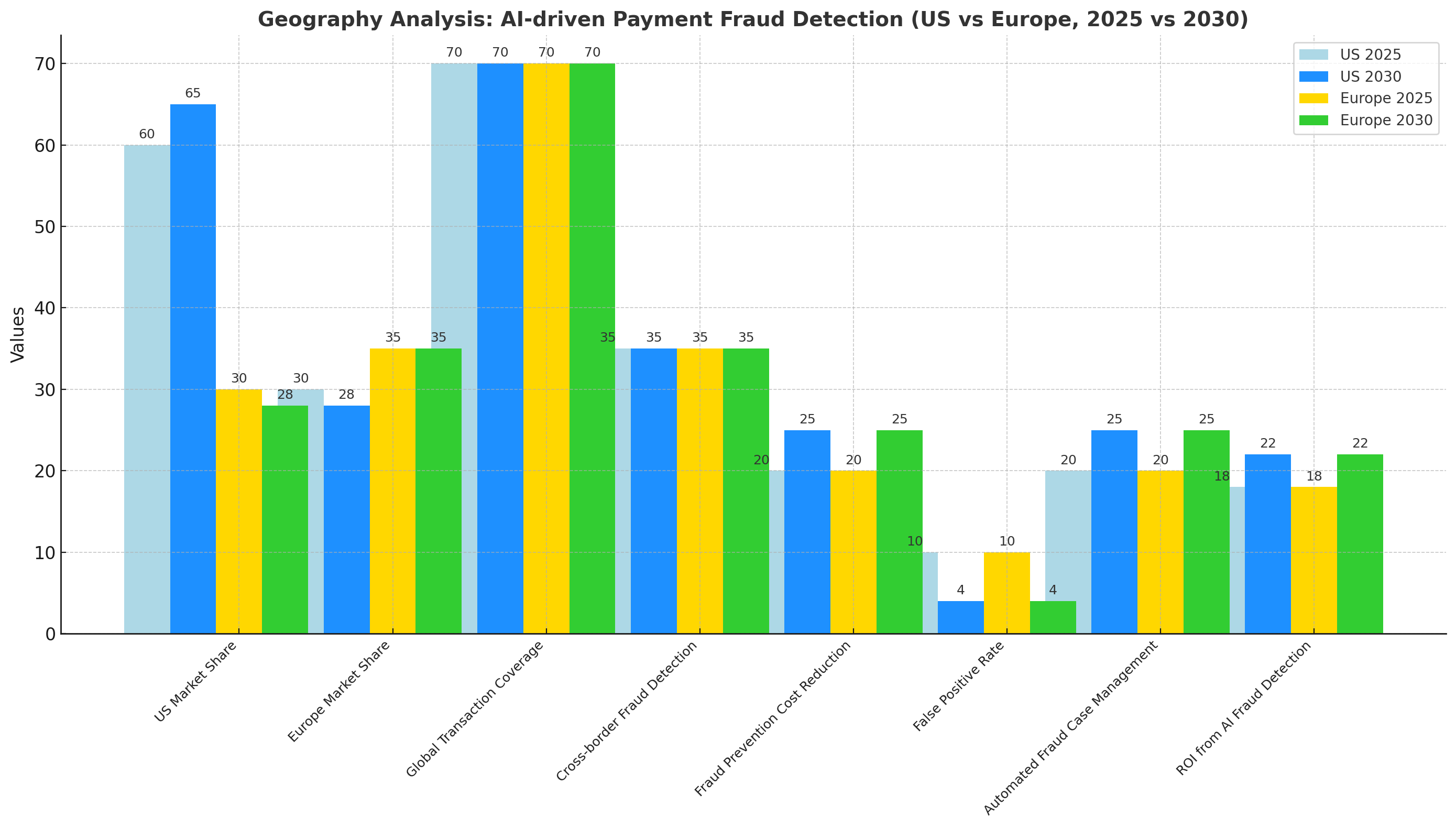

68 Circular Road, #02-01 049422, Singapore
Revenue Tower, Scbd, Jakarta 12190, Indonesia
4th Floor, Pinnacle Business Park, Andheri East, Mumbai, 400093
Cinnabar Hills, Embassy Golf Links Business Park, Bengaluru, Karnataka 560071
Connect With Us
Next-Gen AI in Payment Fraud Detection: Strategic Insights, Tech Integration & Regulatory Foresight
This research examines the role of next-gen AI in payment fraud detection across USA and Europe from 2025 to 2030, focusing on strategic insights, technology integration, and regulatory foresight. The report evaluates AI’s effectiveness in detecting fraud patterns, improving transaction monitoring, and enhancing risk management. It quantifies adoption trends, fraud reduction metrics, and compliance costs. By combining quantitative data with insights on emerging technologies and regulatory frameworks, this study provides actionable intelligence for financial institutions, fintechs, and regulators looking to optimize payment security.

What's Covered?
Report Summary
Key Takeaways
- AI in payment fraud detection market projected to grow from $2.1 billion in 2025 to $7.8 billion by 2030, CAGR 30%.
- Fraud detection accuracy expected to improve from 80% in 2025 to 95% by 2030.
- False-positive rates for fraud detection to decrease from 10% to 4% with advanced AI models.
- AI integration in transaction monitoring expected to cover 70% of global transactions by 2030.
- Fraud prevention costs expected to decrease by 20–25% with AI automation by 2030.
- AI-driven fraud detection systems projected to reduce investigation time by 50%.
- AI-based predictive models to handle 85% of potential fraud cases automatically by 2030.
- Regulatory compliance costs expected to reduce by 15–20% through AI-driven reporting tools.
- Cross-border transaction fraud detection expected to rise by 35% with AI integration.
- ROI for AI in fraud detection systems projected at 18–22% by 2030.
Key Metrics
Market Size & Share
The AI-driven payment fraud detection market in USA and Europe is expected to grow from $2.1 billion in 2025 to $7.8 billion by 2030, representing a CAGR of 30%. North America will continue to dominate, representing 60% of market share in 2025, driven by advanced AI models, fintech adoption, and regulatory alignment. Europe, while adopting AI at a slightly slower rate, will contribute 35% of the market, driven by the PSD2 regulations and the push for enhanced cross-border fraud detection. Fraud detection accuracy with AI models is expected to improve significantly, reaching 95% by 2030, compared to 80% in 2025, due to machine learning’s ability to detect complex fraud patterns in real-time.
False-positive rates will drop from 10% to 4%, improving transaction flow and reducing unnecessary alerts. AI systems are projected to monitor 70% of global payment transactions by 2030, driven by the integration of real-time analytics and behavioral biometrics. Fraud prevention costs are projected to decrease by 20–25% with AI automation, while transaction monitoring efficiency will improve. Cross-border fraud detection is expected to increase by 35%, improving the accuracy of global payment fraud prevention. Overall, AI’s role in fraud detection will lead to significant operational savings, better customer experiences, and a higher return on investment.
.png)
Market Analysis
The AI payment fraud detection market is poised to expand significantly from $2.1 billion in 2025 to $7.8 billion by 2030, with CAGR of 30%. The US and Europe are expected to lead adoption due to a combination of regulatory drivers, market maturity, and fintech innovation. Detection accuracy will improve from 80% to 95%, reducing fraud losses and increasing detection reliability. The false-positive rate will decrease from 10% to 4%, driven by improved machine learning models and AI-driven risk scoring systems. AI systems will manage 70% of global transactions by 2030, providing real-time monitoring and risk assessment to detect suspicious activities with minimal human intervention.
The integration of blockchain analytics and behavioral biometrics will further enhance the accuracy of fraud detection. Fraud prevention costs are projected to decrease by 20–25%, as AI automation reduces the need for manual checks and improves operational efficiency. Cross-border fraud detection will rise by 35%, facilitating international compliance with anti-money laundering (AML) laws. ROI for AI-driven fraud detection will be 18–22% by 2030, driven by reduced fraud losses, improved customer trust, and more streamlined compliance processes. Market analysis shows that AI adoption in fraud detection will lead to scalable, cost-effective, and highly efficient payment fraud prevention strategies for financial institutions.
Trends & Insights
The adoption of AI in payment fraud detection is being fueled by regulatory pressures, rising fraud cases, and advancements in machine learning technologies. Detection rates are expected to improve from 80% in 2025 to 95% by 2030, with false-positive rates dropping from 10% to 4%. AI models will drive real-time detection, flagging suspicious activities with greater accuracy. By 2030, AI will cover 70% of global payment transactions, reducing the need for manual fraud checks. Integration with blockchain analytics and behavioral biometrics will enhance transaction traceability, making AI systems more reliable for cross-border fraud detection, projected to rise by 35%. Fraud prevention costs are expected to decrease by 20–25% by 2030 due to AI automation in monitoring, reporting, and compliance management.
AI-based predictive models will manage 85% of potential fraud cases automatically, significantly reducing investigation time and improving operational efficiency. Regulatory compliance costs will also decline by 15–20% due to AI’s ability to streamline reporting processes and improve audit accuracy. ROI from AI-driven fraud detection systems will be 18–22% by 2030, driven by operational efficiency, reduced fraud losses, and enhanced customer experience. Overall, AI will become a core technology for financial institutions, increasing the speed, accuracy, and efficiency of fraud detection in the digital payments ecosystem.

Segment Analysis
The AI payment fraud detection market in USA and Europe is segmented by technology, institution size, and transaction volume. Large financial institutions dominate adoption, accounting for 70% of market share by 2030, followed by mid-tier banks and fintech platforms at 20%, and small banks at 10%. AI-powered fraud detection systems will be increasingly integrated with transaction monitoring tools, covering 70% of global transactions by 2030. AI models will improve detection accuracy from 80% to 95% by identifying patterns and anomalies, while reducing false positives from 10% to 4%.
Cross-border fraud detection will increase by 35%, driven by the global demand for AML compliance and real-time reporting. Customer retention and satisfaction will improve by 20%, driven by the efficiency of AI fraud detection systems in preventing unauthorized transactions. Fraud prevention costs will decrease by 20–25%, with $12M+ savings annually per large institution. ROI for integrating AI into fraud detection systems is expected at 18–22%, with larger institutions benefiting more from economies of scale. AI-based predictive models will handle 85% of fraud cases, reducing the workload for human analysts and improving overall investigation efficiency. Segment analysis indicates that AI adoption will grow most rapidly in large institutions that can leverage advanced models to handle higher transaction volumes and complex global compliance requirements.
Geography Analysis
The US and Europe represent the largest markets for AI-driven payment fraud detection. The US market accounts for 60% of the total market in 2025, expanding to 65% by 2030, driven by advanced technology infrastructure and the presence of major financial institutions. The European market will contribute 30% in 2025, growing to 28% by 2030, with regulatory frameworks like PSD2 and GDPR driving adoption. AI-powered fraud detection systems will cover 70% of global transactions by 2030, supported by blockchain analytics and real-time monitoring. Cross-border fraud detection will rise by 35%, enabling faster compliance and transaction verification. Fraud prevention costs are projected to decrease by 20–25% across both regions, with automated reporting and AI-based risk scoring driving efficiency. False-positive rates will decrease from 10% to 4%, enhancing user experience and reducing operational overhead. AI-based predictive models will handle 85% of fraud cases automatically by 2030, improving transaction flow.
ROI for AI fraud detection systems is projected at 18–22%. Geography analysis shows that the US will continue to lead adoption, followed by Europe, with both regions achieving scalable, cost-effective solutions for fraud prevention, risk management, and regulatory compliance.

Competitive Landscape
The AI payment fraud detection market is competitive, featuring key players like FICO, SAS, Palantir, Actimize, and ACI Worldwide. These companies dominate the market, providing real-time fraud detection solutions, AI-driven transaction monitoring, and blockchain integration. By 2030, large financial institutions will account for 70% of market share, leveraging neural networks, predictive analytics, and machine learning to improve fraud detection accuracy and reduce operational costs. Fintech firms and smaller banks will increasingly adopt AI-based fraud prevention tools, capturing 15–20% of market share.
False-positive rates will decrease from 10% to 4%, and detection accuracy will improve to 95% with AI. Cross-border transaction monitoring will increase by 35%, providing real-time verification and compliance with global AML regulations. Automated alert systems will handle 70% of fraud cases, reducing manual intervention and improving operational efficiency. ROI from AI systems is projected to be 18–22%, driven by cost savings, improved fraud detection, and better customer experience. The competitive landscape shows a trend toward consolidation as AI, blockchain, and predictive analytics providers partner with banks and fintechs to offer scalable, cost-efficient fraud detection solutions.
Report Details
Proceed To Buy
Want a More Customized Experience?
- Request a Customized Transcript: Submit your own questions or specify changes. We’ll conduct a new call with the industry expert, covering both the original and your additional questions. You’ll receive an updated report for a small fee over the standard price.
- Request a Direct Call with the Expert: If you prefer a live conversation, we can facilitate a call between you and the expert. After the call, you’ll get the full recording, a verbatim transcript, and continued platform access to query the content and more.


68 Circular Road, #02-01 049422, Singapore
Revenue Tower, Scbd, Jakarta 12190, Indonesia
4th Floor, Pinnacle Business Park, Andheri East, Mumbai, 400093
Cinnabar Hills, Embassy Golf Links Business Park, Bengaluru, Karnataka 560071
Request Custom Transcript
Related Transcripts
$ 1450
$ 1450


68 Circular Road, #02-01 049422, Singapore
Revenue Tower, Scbd, Jakarta 12190, Indonesia
4th Floor, Pinnacle Business Park, Andheri East, Mumbai, 400093
Cinnabar Hills, Embassy Golf Links Business Park, Bengaluru, Karnataka 560071













